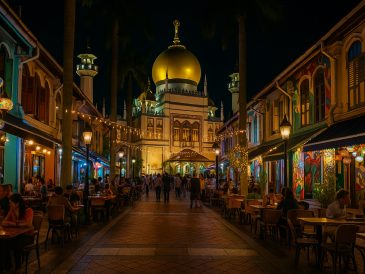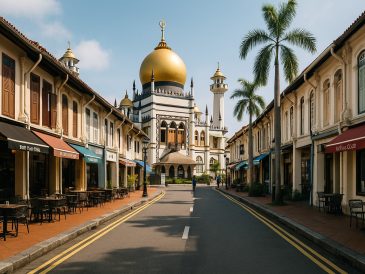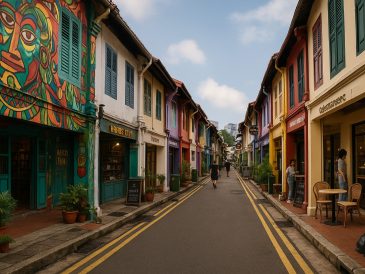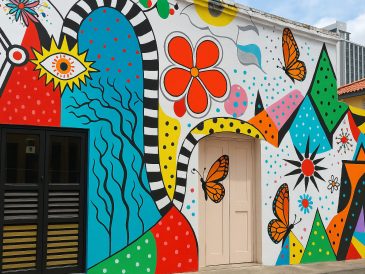Bussorah Street offers a rare mix of heritage, culture, architecture, and cuisine in a compact, pedestrian-only strip in Kampong Glam, Singapore. If you’re searching for a place that offers history with character, shophouses with stories, and food that lingers in memory, this street answers that need effortlessly.
A Historical Artery with a Spiritual Past
Once known as Sultan Road, Bussorah Street earned its present name in 1910, inspired by Basra (then Bussorah), a city in Iraq. In the 19th century, Arab traders and merchants made it a thriving commercial hub. Its stretch near Sultan Mosque held a special purpose—it served as a waystation for Indonesian pilgrims preparing for the Hajj. The area was known as Kampong Kaji, or Pilgrim Village. ‘Sheikh hajis’ provided spiritual and logistical support to pilgrims, some of whom would spend days, even weeks, here before setting sail to Mecca. The term Kampong Kaji still carries meaning among older residents.
The street today symbolizes Singapore’s multicultural fabric, where Arab, Malay, and Indian communities have coexisted and influenced each other for generations. Bussorah Street also leads directly to the entrance of Sultan Mosque, one of the country’s most significant Islamic landmarks.
Architecture That Breathes
The architecture here offers more than aesthetic appeal. It’s functional, historical, and representative of cross-cultural styles. The two- and three-story shophouses lining the street were built between 1840 and 1900. Originally designed with a commercial ground floor and residential upper levels, these buildings use architectural features suited to Singapore’s tropical climate—high ceilings, airwells, and overlapping roof tiles.
One of the defining features is the “five-foot way,” a covered verandah concept mandated by Sir Stamford Raffles, offering continuous shade and shelter for pedestrians. This concept has remained intact, even after the street’s conversion into a pedestrian-only zone.
Shopping with Meaning
Bussorah Street is ideal for anyone who prefers buying goods with character. The retail experience here leans toward the artisanal and the culturally significant.
What You Can Find:
- Persian Carpets and Rugs: Authentic, handwoven pieces with deep-rooted traditions.
- Antiques and Collectibles: Items that often carry generational stories.
- Turkish Lanterns: Vibrant and decorative, these are popular for their handmade glass mosaic finishes.
- Wardah Books: A specialty bookstore at No. 58 Bussorah Street, focusing on Islamic thought, Sufism, and Muslim culture.
- Perfumeries: Fragrant oils and attars reminiscent of Middle Eastern bazaars.
- Handicrafts and Accessories: Textiles, jewelry, and embroidered items made by local and regional artisans.
The shopping experience here doesn’t feel transactional. Every item often comes with a background or tradition that informs its design.
Where to Eat: Authenticity Served Hot
This street is a stronghold of flavor. From street-style kebabs to comfort food that blends cultural influences, the variety available can fill more than just a stomach.
Notable Dining Spots:
- Kampong Glam Cafe & Bistro
A mix of Malay and Middle Eastern cuisine served in a casual, friendly atmosphere. - Padi @ Bussorah
Wallet-friendly Malay dishes, perfect for those seeking traditional tastes. - Tabbouleh Lebanese Restaurant
Offers fresh Lebanese cuisine, including hummus, tabbouleh, and grilled meats. - The Malayan Council (TMC Bussorah)
Known for its “West-Meets-Malaya” menu—think smoked duck lemak chili padi pasta and durian creme brulee. - Beirut Grill
Serves up spiced meats and mezze with the Sultan Mosque as its backdrop. - Flying Monkey
Specializes in pan-Indian cuisine and cocktails crafted with Indian spices.
Dining here becomes part of the street’s story. Most venues open before noon, but the area really begins to buzz by late afternoon and continues into the night.
Events and Community Life
During Ramadan, Bussorah Street transforms into an open-air venue lined with food stalls selling local Malay delicacies. Families gather, prayers echo from the mosque, and the scent of grilled meats and sweet treats fills the air. The street also becomes a stage for cultural exhibitions during the Singapore Heritage Festival. Past events have included workshops on Bangsawan, a form of traditional Malay opera.
These events don’t feel like performances for tourists; they’re community-driven experiences that invite participation rather than just observation.
Beyond the Street
Though Bussorah Street could easily occupy an entire afternoon, the surrounding area adds further dimension.
Nearby Highlights:
- Haji Lane
A short walk away, this narrow alley is lined with indie boutiques, street art, and cafes. - Arab Street
Known for its textile stores and vibrant imports such as prayer rugs and Turkish lamps. - Sultan Mosque
A national monument with a striking golden dome, open to visitors outside of prayer times. - Malay Heritage Centre
Housed in a former royal palace, this museum provides historical context to the area’s cultural roots.
Why Bussorah Street Matters
This street succeeds where many cultural areas fail—it has maintained its soul without becoming a replica of itself. It functions not only as a tourist attraction but as a lived-in space where people pray, trade, eat, and gather. Bussorah Street doesn’t try to imitate history—it is history, preserved in architecture, food, books, and community life.
Whether you’re walking through its shaded five-foot ways, browsing through a perfumery, or sipping mint tea at a sidewalk table, every experience here adds another layer to the understanding of Singapore’s cultural mosaic.




